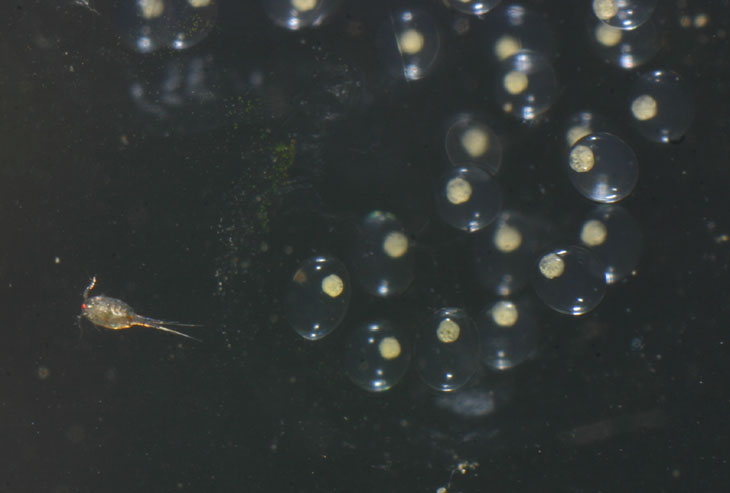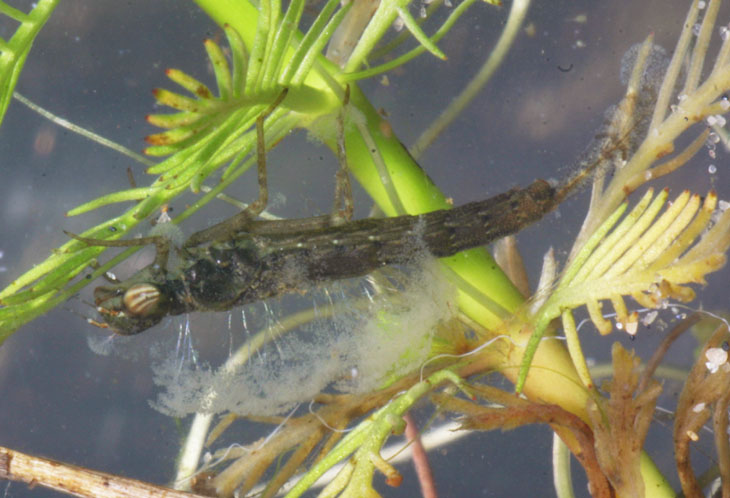
When I was in Florida, I maintained a saltwater aquarium in the most casual way possible, by simply replenishing it with water from the nearby Indian River Lagoon routinely. The occupants were primarily porcelain crabs, tiny hermit crabs, and grass shrimp, all hardy and easy-to-feed critters. Since grass shrimp (too often called “ghost shrimp”) are available at some aquarium shops in the area, I’m considering getting a few as photographic subjects (and just ’cause I like ’em) and so dug out the small, cheap fish tank that I have. And since aquatic life is already visible in the streams and ponds around here, I collected some local water and debris, kind of as a warmup to see just what could be found.
 The main thing that I caught were snails and copepods, no surprise. Copepods are not-quite-microscopic aquatic organisms that are exceptionally common and definitely exotic-looking, but also hyperactive and hard to photograph, not the least because of their size. One can be seen in the photo at top, on the left. But the snails busied themselves with laying eggs all over the sides of the aquarium, also seen in that image, which means I’ll be holding off on switching this over to a saltwater tank for a little while, since this presents an opportunity that I don’t want to pass up: hatching! Seen here, one of the larger snails has been captured in the process of producing yet another egg sac, sticking it directly to the aquarium side. In natural conditions, such snails attach their eggs to rocks, twigs, and debris, usually in sheltered conditions – I had collected some others on dead leaves from the pond edges. If it helps, the snail itself is about 2 cm long – and the back end of the snail is towards the top of the image. Yeah, snail anatomy is kind of weird.
The main thing that I caught were snails and copepods, no surprise. Copepods are not-quite-microscopic aquatic organisms that are exceptionally common and definitely exotic-looking, but also hyperactive and hard to photograph, not the least because of their size. One can be seen in the photo at top, on the left. But the snails busied themselves with laying eggs all over the sides of the aquarium, also seen in that image, which means I’ll be holding off on switching this over to a saltwater tank for a little while, since this presents an opportunity that I don’t want to pass up: hatching! Seen here, one of the larger snails has been captured in the process of producing yet another egg sac, sticking it directly to the aquarium side. In natural conditions, such snails attach their eggs to rocks, twigs, and debris, usually in sheltered conditions – I had collected some others on dead leaves from the pond edges. If it helps, the snail itself is about 2 cm long – and the back end of the snail is towards the top of the image. Yeah, snail anatomy is kind of weird.
The gestation time varies with the species and the temperature, so I can expect anywhere from one to five weeks until they hatch, but likely on the shorter end of that because they’re indoors now, much warmer than the ponds outdoors. Somewhat frustrating, however, is the fact that the small tank is only plastic, and significantly marked and scratched, so it’s far from the best photographic conditions. I had planned to swap out one side with a piece of glass, like the macro tank seen here, but like a dummy I put the sample water in it before I tackled that project, and now I have to shoot through the scratches. My planning could have been a little better.
 While I’m not going to be moving the egg sacs adhering to the sides, I can still transfer other subjects into the macro tank for better images. Aside from having clean and unmarked glass to shoot through, providing less distortion and things to scatter the lighting from, the smaller tank means that I can keep photo subjects closer to the front (less suspended sediment to shoot through,) manage the setting easier, and put my lighting anywhere it’s needed, including behind or underneath the tank. Tiny yet perpetually active subjects like this water beetle still have a lot of room to hurtle around within, but will now pass within view of the camera more often, and remaining focused at the water’s edge improves those odds quite a bit. Using the bellows like I was here requires manually closing the aperture down after achieving tight focus, which darkens the viewfinder pretty much to the point of ineffectiveness, so it means align the camera, focus sharply, and then close the aperture down and snap the image quickly before the subject gets bored and leaves, all while not bumping the rig in the slightest. The aperture needs to be quite small to extend the limited depth of field as much as possible; even with this, effective sharp focus is usually measured in millimeters. But with a small tank you can pick a particular area that is distinctive, focus and set aperture, then simply watch the tank without having to have your eye at the viewfinder, tripping the shutter when the subject enters your viewing area. This is helped by using a fairly high shutter speed and a flash/strobe to prevent any motion blur. A word of warning for those who want to try macro tank photography, though: at high magnifications, you find out just how hard it is to keep everything clean, and tank sides that appeared perfectly clear will show the hairs and schmutz that sneak in constantly. Often it’s hard to stay on top of the air bubbles that form constantly against the glass, requiring their dislodging just when you think you’ve got everything arranged, and as seen here, a tissue is a lot less useful to clean the outsides than you’d expect – those white squiggles are paper fibers. It goes without saying that difficult subjects always choose to pose helpfully right alongside something that you don’t want in the photo.
While I’m not going to be moving the egg sacs adhering to the sides, I can still transfer other subjects into the macro tank for better images. Aside from having clean and unmarked glass to shoot through, providing less distortion and things to scatter the lighting from, the smaller tank means that I can keep photo subjects closer to the front (less suspended sediment to shoot through,) manage the setting easier, and put my lighting anywhere it’s needed, including behind or underneath the tank. Tiny yet perpetually active subjects like this water beetle still have a lot of room to hurtle around within, but will now pass within view of the camera more often, and remaining focused at the water’s edge improves those odds quite a bit. Using the bellows like I was here requires manually closing the aperture down after achieving tight focus, which darkens the viewfinder pretty much to the point of ineffectiveness, so it means align the camera, focus sharply, and then close the aperture down and snap the image quickly before the subject gets bored and leaves, all while not bumping the rig in the slightest. The aperture needs to be quite small to extend the limited depth of field as much as possible; even with this, effective sharp focus is usually measured in millimeters. But with a small tank you can pick a particular area that is distinctive, focus and set aperture, then simply watch the tank without having to have your eye at the viewfinder, tripping the shutter when the subject enters your viewing area. This is helped by using a fairly high shutter speed and a flash/strobe to prevent any motion blur. A word of warning for those who want to try macro tank photography, though: at high magnifications, you find out just how hard it is to keep everything clean, and tank sides that appeared perfectly clear will show the hairs and schmutz that sneak in constantly. Often it’s hard to stay on top of the air bubbles that form constantly against the glass, requiring their dislodging just when you think you’ve got everything arranged, and as seen here, a tissue is a lot less useful to clean the outsides than you’d expect – those white squiggles are paper fibers. It goes without saying that difficult subjects always choose to pose helpfully right alongside something that you don’t want in the photo.

Another capture was a dragonfly nymph, the larval form that is as serious a predator upon aquatic critters as the adult form is upon flying insects. This one is sporting some kind of atypical appendages that, while FAB-u-lous!, are probably some kind of fungal growth and none too healthy. While appearing to be less active than the water beetles, dragonfly larva have this habit where they wait until you’ve got focus nicely pinned down and then move a little bit or change poses, something that any child photographer probably knows only too well. Did I forget to mention lighting tests? Yeah, TTL flashes are pretty undependable for macro work, especially when using a bellows which won’t feed aperture info into the camera, so you’re going full manual lighting with such setups, and will spend no small amount of time adjusting both light intensity and angle. While a strobe with adjustable output is not absolutely necessary, it will make your life much easier, as will a manner of repositioning and angling it quickly. Nevertheless, once a few tests have determined just what power and angle are working best, that’s when the nymph goes behind your setting. You should rest assured, however, that a gentle nudge to move it back out into the open will sending it swimming frantically all around the tank instead.

It may take a lot of frames and an abundance of patience, but eventually some compelling images can be captured, and with aquatic subjects it doesn’t matter how much or loudly you swear (I say smugly to the child photographers.) Collecting these subjects, by the way, required a jar and access to a pair of ponds, assisted by no aversion to getting a little muddy, so it’s not like stalking lions on the African veldt. Coming soon, I’ll detail another method of getting extreme closeups that is easier to arrange than you might have suspected.




















































